The Latest from Boing Boing |  |
- First-person account from surgeon who removed his own appendix
- UN approves military intervention to protect Free Benghazi
- Operation Tomodachi: photos from US Navy's Japan disaster relief operation
- Japan nuclear crisis update: "Frantic" efforts continue, "Chernobyl solution" not ruled out
- Japan TV dioramas of stricken Fukushima nuclear plant are dissonantly adorable
- US military launches Operation Sock Puppet, pays contractor $2.76m for social media ops (UPDATED)
- Japan nuclear crisis: "Should I take potassium iodide pills to protect against radiation exposure?"
- Japan: Citing Wikileaks cables, news reports of TEPCO history of lying, falsifying safety records
- Japan: Prime Minister issues advisory on radioactivity and food safety
- US Congress votes to kill federal funding of public radio
- Japan: Bird's-eye view of Fukushima nuclear power plant (video)
- Threadless tee strikingly similar to Imaginary Foundation graphic leads to contest benefiting CC
- Rejected by Bahrain
- Pink iPod Nano watch band
- Radiation dose and risk table
- An easy-clean metal filter for Aeropress
- Hexayurt
- It would surely ruin everyone's day if Nuclear Boy pooped
- Adam Wallacavage's tentacled, curious, and creepy chandeliers
- Japan nuclear crisis: Where are the robots?
- X-ray machine from 1895
- New York Times paywall: wishful thinking or just crazy?
- 3 years in the slushpile
- Let's hope they have robotic fire trucks in Fukushima
- The Blank Page
- Nursery Rhymes: iOS app for parents who don't have time for their kids
- How nuclear reactor design played a role in Fukushima crisis
- The Decemberists by Scott Compton (Boing Boing Video)
- Young teen makes candles with "manly" scents
- World's largest spam botnet goes down (for now?)
| First-person account from surgeon who removed his own appendix Posted: 17 Mar 2011 11:45 PM PDT From The Atlantic's archives, a harrowing 1961 account of a Soviet surgeon on a primitive Antarctic base who had to remove his own appendix, stopping frequently as he battled vertigo and blood loss: Antarctica, 1961: A Soviet Surgeon Has to Remove His Own Appendix |
| UN approves military intervention to protect Free Benghazi Posted: 17 Mar 2011 11:24 PM PDT The UN Security Council has approved air strikes against Gadaffi loyalist forces and the Gadaffi mercenary army as they advance on "Free Benghazi," the Libyan rebel stronghold. In response, Gadaffi told a Portuguese TV station, "This is craziness, madness, arrogance. If the world gets crazy with us we will get crazy too. We will respond. We will make their lives hell because they are making our lives hell. They will never have peace." The no-fly zone and intervention will be enforced with support from Arab League members who earlier passed a resolution calling on the UN to take action (the Arab League has always had a fraught relationship with Gadaffi, whose presence at League meetings has been marked by the aforementioned "crazy"). Libya resolution: UN security council air strikes vote - as it happened |
| Operation Tomodachi: photos from US Navy's Japan disaster relief operation Posted: 17 Mar 2011 09:23 PM PDT 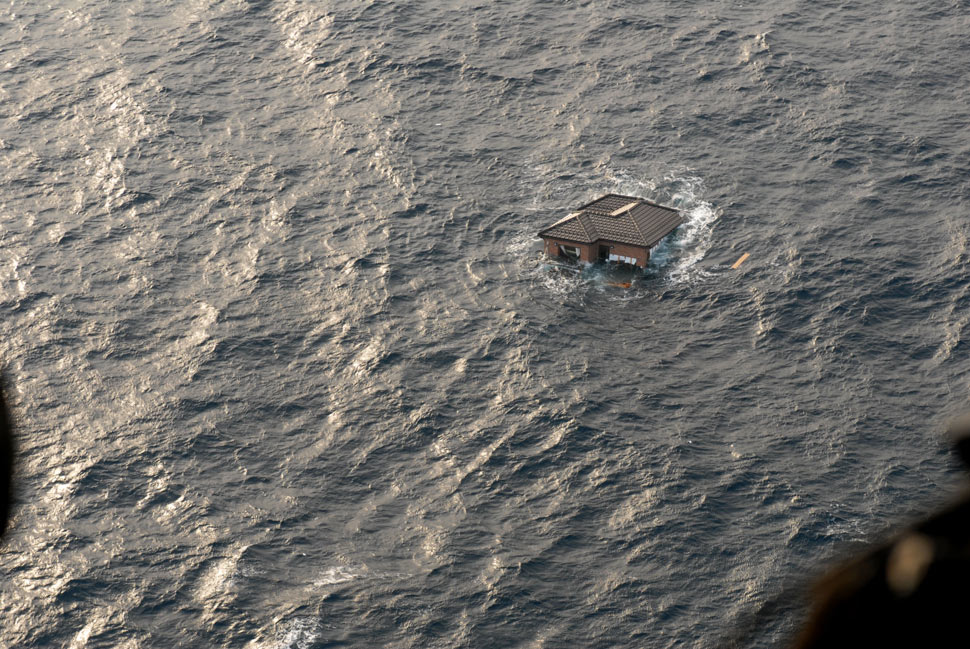 The US Navy has published a set of photos related to the "Operation Tomodachi" disaster relief mission in quake- and tsunami-stricken Japan. About the photo above, by Mass Communication Specialist 3rd Class Dylan McCord: PACIFIC OCEAN (March 13, 2011) A Japanese home is seen adrift in the Pacific Ocean. Ships and aircraft from the Ronald Reagan Carrier Strike Group are searching for survivors in the coastal waters near Sendai, Japan. Direct link to photo, and here is the entire set of Operation Tomodachi images. |
| Japan nuclear crisis update: "Frantic" efforts continue, "Chernobyl solution" not ruled out Posted: 17 Mar 2011 09:32 PM PDT  An update on the ongoing crisis at the Fukushima nuclear power plants in Japan, damaged after a massive earthquake and tsunami hit, and now leaking radiation with no power and no clear way to cool down fuel rods and spent fuel: • Above, partial screengrab from a chart showing radiation readings for Japan by prefecture. Spotted in the Twitter stream of VOA correspondent Steve Herman, who adds, "[Note that there are] NO readings posted any longer from here in Fukushima-ken." • The official death toll from the tsunami and earthquake in Japan: 6,405. Approximatelyl 16,000 are believed missing or unaccounted for. • In a press briefing, Japan's nuclear safety agency stated that it was aware of the so-called "Chernobyl solution" -- covering it in sand and encasing it in concrete. But for now, the government is focusing on efforts to restore power and cool down the reactors. In the same briefing, the agency acknowleged that there is either smoke or steam rising from the No. 2 reactor; could be either the spent fuel pool or an explosion in the suppression chamber, nobody knows yet. • In a separate press conference, a government spokesman said that work at Fukushima today was focused on restoring electrical power needed to cool the crippled plant. (As I understand it, this would involve an electrical cable about a half a mile long.--XJ) Without power, emergency efforts over the past 24 hours included the extraordinary and unprecedented attempt to re-fill cooling pools by dropping water from helicopters and spraying it from water cannon trucks. More on the effort to restore power in this Reuters item. • The New York Times describes repair efforts as "frantic": "The first readings from American data-collection flights over the stricken Fukushima Daiichi nuclear plant in northeastern Japan show that the worst contamination has not spread beyond the 19-mile range of highest concern established by Japanese authorities. But another day of frantic efforts to cool nuclear fuel in the stricken reactors and the plant's spent-fuel pools resulted in little or no progress, according to United States government officials." See also this excellent infographic feature at the Times with current status of each of the reactors, and this very detailed map of the evacuation zone, with corresponding radiation levels.
• The head of the IAEA, the UN's nuclear watchdog agency, will meet on this afternoon with Japan's Prime Minister Kan to discuss the nuclear crisis. (Kyodo)
• During a press conference held by Yukio Edano, the Japan government spokesperson says the nation has not turned down offers of assistance in the nuclear crisis from the US, and that they've been requesting help.
• Edano also said that general radiation levels are still not at a level that poses a threat to human health. With regard to the operations over the past two days: water levels at the cooling pool at Reactor No. 3, which has been of great concern, have risen after aerial drops and water cannon sprays--but they are not sure how much.
• The commander of US military forces in the Pacific gave a briefing today on efforts to help Japan.
• TEPCO, the company that operates the Fukushima plant, also gave a press conference today. They hope to get power to reactors No. 1 and 2 today; 3 and 4 by Saturday March 20. TEPCO has 50 workers at the plant, working in shifts to keep radiation exposure to each individual down as much as possible.
|
| Japan TV dioramas of stricken Fukushima nuclear plant are dissonantly adorable Posted: 17 Mar 2011 03:43 PM PDT 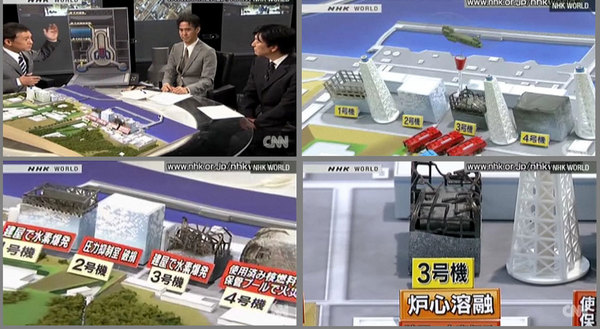 (screengrabs from NHK, courtesy IZ RELOADED) During a live broadcast yesterday, the Japanese television network NHK unveiled a hand-crafted scale model of the damaged Fukishima Daiichi nuclear plant. Like the cardboard infographics their nuclear experts have been pointing to on-air since the nuclear crisis began, this diorama is a key part of their news presentation, a visual aid of sorts. There is nothing cute or cool about the multiple disasters that have struck Japan: the earthquake and tsunami have already claimed at least 5,000 lives and perhaps many more; tens of thousands are already known to be missing or displaced. The still-unfolding nuclear accident is serious, and could have grave consequences for Japan. But the miniature models of Fukishima, a word that now inspires fear and iodide pill hoarding in people around the world--well, they are so cute, as one person said on Twitter today, you almost want to adopt one. As Matt Alt tweeted from Tokyo during the broadcast, "I'd just like to say 'mad hugs' to NHK for debuting the helicopter model on the reactor diorama." There is something comforting about them. Comforting like the calm voice of the female translator I listened to on NHK English last night, while helicopters flew into the mouth of the radioactive beast, as it were, to drop water on reactor number 3. Comforting, perhaps, because they seem so tiny and familiar, while what is at stake is so huge and unknown. I.Z. Reloaded from Singapore blogs a bunch of screenshots here: "Diorama of damaged Japanese nuclear station shows how cool Japanese TV really is" |
| US military launches Operation Sock Puppet, pays contractor $2.76m for social media ops (UPDATED) Posted: 17 Mar 2011 07:18 PM PDT From the Your Tax Dollars at Work file, news that the US military's Central Command (CENTCOM) has awarded a $2.7 million contract to Ntrepid, a newly-formed Los Angeles-based startup, to create fake online "personae" for the purpose of manipulating online conversations and spreading pro-American, pro-military propaganda in social media. The "online persona management service" called for in the contract would permit one US serviceman or woman to manage up to 10 separate sock puppets. The Guardian article today says the program would make it possible to "secretly manipulate social media sites such as Facebook and Twitter." CENTCOM disagrees with this characterization of the program, and their statement to Boing Boing is at the bottom of this post. Snip from Guardian: The Centcom contract stipulates that each fake online persona must have a convincing background, history and supporting details, and that up to 50 US-based controllers should be able to operate false identities from their workstations "without fear of being discovered by sophisticated adversaries". Centcom spokesman Commander Bill Speaks said: "The technology supports classified blogging activities on foreign-language websites to enable Centcom to counter violent extremist and enemy propaganda outside the US." He said none of the interventions would be in English, as it would be unlawful to "address US audiences" with such technology, and any English-language use of social media by Centcom was always clearly attributed. The languages in which the interventions are conducted include Arabic, Farsi, Urdu and Pashto. Read the whole article in the Guardian: "Revealed: US spy operation that manipulates social media" Update: Commander Bill Speaks of the Centcom public affairs office, who is quoted in the Guardian piece excerpted above, tells Boing Boing: Regarding your post, I want to make clear that the persona management software contract discussed in Ian Cobain's Guardian story is not, and will not, be used in any online engagements with US audiences, or on web sites based in the US. This includes, of course, Facebook and Twitter. |
| Japan nuclear crisis: "Should I take potassium iodide pills to protect against radiation exposure?" Posted: 17 Mar 2011 02:51 PM PDT  In the past couple of days, as many of us around the world began thinking seriously about the fallout from the damaged nuclear reactors at Fukushima, Japan, I've gotten lots of questions about potassium iodide pills—"Why do people take them?", "How do they work?", "Should my family take them?"
I've spoken with several health physicists—researchers at American universities and at the Mayo Clinic—and I think that I can now answer these questions well enough to post something to BoingBoing. This is a scary, nerve-wracking topic for a lot of people, so I'm not going to bury the information down in a narrative. We'll just get right to the point. In fact, I think that I can clear up most of the confusion by answering four questions. What are potassium iodide pills? Basically, potassium iodide is just a specific kind of salt. Nothing fancy. The same stuff is often put into table salt as a way to get iodine into the diets of people who don't eat much naturally iodine-containing food. Iodine, itself, is an element that's important to the human body. Without it, the thyroid gland can't make certain hormones. If you don't eat enough iodine, especially as a kid, you'll end up with goiters, fatigue, depression—and worse. Thanks to iodized salt (and diverse diets), those of us who live in industrialized nations don't have to think about whether we're getting enough iodine. And, thus, we don't think too much about potassium iodide. Until there's a risk of radioactive fallout. How do potassium iodide pills protect against radiation? Elements come in two forms: Stable and radioactive, the latter of which are prone to breaking apart, shooting out particles that can damage cells and DNA. There's good ol' stable iodine—the stuff that keeps our bodies functioning properly. And there's radioactive iodine—which is dangerous. Radioactive iodine is dangerous precisely because, within the human body, it does the same thing that stable iodine does. It goes straight to the thyroid gland. Once there, radioactive iodine can damage cells and DNA and increases the risk of thyroid cancer. But, there's a catch. The thyroid can only hold so much iodine at a time. Once the shelves are full, any new iodine that shows up is simply excreted back out of the body until the supply needs to be restocked again. That's where potassium iodide pills come in. If radioactive iodine is present, you can prevent it from getting into your thyroid gland by having the gland already full of stable, safe iodine—the kind found in potassium iodide pills. Because radioactive iodine has a short half-life—by this Saturday, March 19, half of all the radioactive iodine released by the reactors at Fukushima will be gone—affected people don't have to take potassium iodide pills forever. Just long enough for the radioactive iodine to break apart and vanish. Key takeaway from this part: Potassium iodide pills will only protect against the effects of radioactive iodine in the thyroid. There's other radioisotopes being released by the Fukushima reactors, and potassium iodide can't do anything about them. What are the risks of taking potassium iodide pills? There are risks. The big one: You might be allergic to potassium iodide pills. This is particularly likely if you are already allergic to shellfish. The allergic reactions could be life threatening, and there's not really a good way to know whether you'll be allergic to the pills until you try one. But there's another risk, too. There's not an unlimited supply of potassium iodide pills. If people living in places unaffected by radioactive iodine buy up lots of potassium iodide pills, it means there are fewer of those pills available for the people who really need them. That's why the Union of Concerned Scientists recently put out a press release asking Americans to refrain from buying—or, worse, stockpiling—supplies of potassium iodide pills. People in Japan need them. Which brings us to the final question: Will radioactive fallout from Fukushima reach the West Coast of the United States? The answer depends on what you mean. If you mean, "Will radioactive fallout from Japan reach the West Coast in quantities that could increase the risk of cancer for me and my family?" Then the answer is, "No." The risks of exposure to radiation are dependent on the dose. As it travels across the Pacific Ocean, the concentrated radioactive fallout that leaves Fukushima will become diluted—some will fall out into the ocean, some will drift away on the breeze, some of the isotopes—including radioactive iodine—will even break apart, becoming something else, something not dangerous. By the time any of the radioactive isotopes reach American shores, the fallout will be so dilute that radiation will have dropped well below the levels that cause detectable increases in the risk of cancer. There will not be a reason for Americans to worry about their health. This is according to Kelly Classic, radiation physicist at the Mayo Clinic; Kimberlee Kearfott, health physicist at the University of Michigan; Ralf Sudowe, health physicist at the University of Nevada Las Vegas; Kathryn A. Higley, health physicist at Oregon State University; Jason T. Harris, health physicist at Idaho State University and, if you read the link above, The Union of Concerned Scientists. It will be possible to detect radiation from Fukushima in the United States. But that's because the tools we have for detecting radiation are incredibly sensitive. We can spot radiation at levels far lower than those that can actually increase our risk of cancer. Frankly, that's a good thing. It means we can see problems before they build into something serious. It means we can accurately measure dangerous levels of radiation without having to get scientists too close to the radiation source. And, it will mean that we will be able to see very low levels of radiation from Fukushima in the United States, even though the risk from that radiation will be something we can shrug off. I know this doesn't answer all of your questions, but I hope it helps. I'll be back tomorrow with more information on issues like what happens to radioisotopes that get inside your body, how Fukushima will affect the food chain, why it's mostly OK for radioisotopes to fall into the Pacific Ocean. EDIT: Charles Q. Choi, a science journalist who is currently reporting from Chernobyl, spotted a quick fact that I forgot to mention. Based on the available evidence, thyroid cancer caused by exposure to radioactive iodine seems to be a problem primarily for children, rather than adults. Image: Some rights reserved by ark |
| Japan: Citing Wikileaks cables, news reports of TEPCO history of lying, falsifying safety records Posted: 17 Mar 2011 01:31 PM PDT Tokyo Electric Power Company (TEPCO), the Japanese owner of the stricken Fukushima nuclear plant, falsified safety data and "dishonestly" tried to cover up problems there, according to reports based on Wikileaks-leaked cables (The Australian). |
| Japan: Prime Minister issues advisory on radioactivity and food safety Posted: 17 Mar 2011 01:23 PM PDT Strange times. The office of the Prime Minister of Japan has issued an update to the country's Food Sanitation Act, in light of the "nuclear state of emergency" declared after the accident at TEPCO's Fukushima Daiichi Nuclear Power Plant. We would like you to take adequate measures in terms of sales and other areas, to ensure that such foods are not supplied to the public to eat. Inspections shall be conducted by referring to the office memo "Manual for Measuring Radioactivity of Foods in Case of Emergency." Here's the notice from the prime minister's office: Japanese, English via Google Translate, contains links to official English language press release. |
| US Congress votes to kill federal funding of public radio Posted: 17 Mar 2011 01:11 PM PDT "The House of Representatives approved a measure Thursday to bar federal funding of National Public Radio. The bill also prohibits public radio stations from using federal grant money to pay dues to NPR." |
| Japan: Bird's-eye view of Fukushima nuclear power plant (video) Posted: 17 Mar 2011 12:49 PM PDT [Video Link]. The title, from Japanese: "Fukushima Daiichi Nuclear Power Station from the air." Shot after multiple explosions damaged multiple structures at the site. |
| Threadless tee strikingly similar to Imaginary Foundation graphic leads to contest benefiting CC Posted: 17 Mar 2011 01:29 PM PDT .jpg) In 2005, our friends at surrealist clothier and thinktank Imaginary Foundation created the design above left, "Music is a Force of Nature." Recently, IF designer Nick Philip spotted the, er, similar graphic above right for sale on a Threadless t-shirt. Nick wasn't particularly shocked or upset, as t-shirts that appear to have bitten IF's graphics show up online and even at mall chains with some frequency. In fact, Imaginary's own roots are in the Dada-inspired culture of collage and appropriation. But this time, Imaginary Foundation has decided to act. No, they didn't have their lawyers send a nastygram. Instead, Nick made the "source files" of the Force of Nature t-shirt available for free and is encouraging remixing. IF's Director will then pick his favorite design and have it printed on an Imaginary Foundation t-shirt with full credit to the artist. All proceeds from the shirt sales will then be donated to, you guessed it, Creative Commons! Good on ya, Imaginary Foundation! Evolve and Remix |
| Posted: 17 Mar 2011 12:44 PM PDT 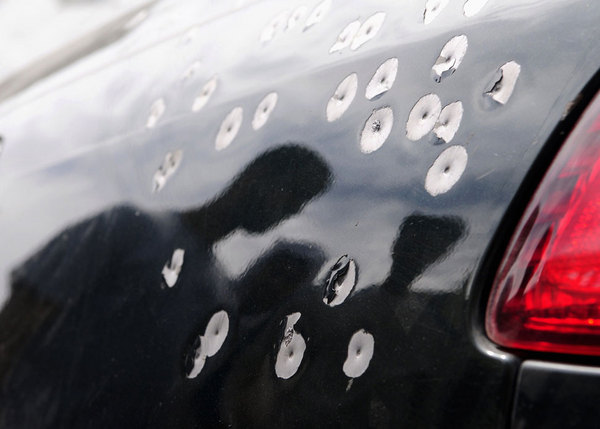 Photo: Anti-government protesters' reflections are seen on a car that was hit by bullets during an operation by Gulf Cooperation Council (GCC) military forces to remove protesters from Pearl Square in Bahrain, March 17, 2011. (REUTERS/James Lawler Duggan) Photo: Anti-government protesters' reflections are seen on a car that was hit by bullets during an operation by Gulf Cooperation Council (GCC) military forces to remove protesters from Pearl Square in Bahrain, March 17, 2011. (REUTERS/James Lawler Duggan) Bahrain awoke to a violent crackdown by police on demonstrators camped out at the country's iconic Lulu (Pearl) roundabout on Wednesday. That afternoon, I boarded a flight from Doha, Qatar to Bahrain, to see for myself what was unfolding in the island nation I once called home. Hours later, I found myself on a flight back to Doha, without having been allowed to set foot out of Bahrain's airport in Muharraq. The flight itself was quite uneventful. The plane - an Airbus A321, with a listed 177 passenger capacity - carried less than 30 people. A short line to immigration meant I was at the desk in minutes. Immigration officer asks, "Where are you coming from? Qatar? OK, 5 Bahraini Dinars." Thumbing through my passport, he suddenly stops and looks me in the eye. "Wait, where are you from? Who do you work for? ... Please have a seat - over there." I can't be sure if it was the Iraq visa, the India visa, or the numerous Qatar & Saudi visas in my American passport he found suspicious. Or perhaps it was my telling him in Arabic that "my origin" is half Indian, half Hispanic. So my wait began. There were quite a number of other people on the benches too. Anyone who'd arrived with the intention of driving across the King Fahad causeway into Saudi Arabia was being told they'd have to fly. There is a curfew in effect on Bahrain's main highway from 4pm-4am, and last I heard, the bridge to Saudi was closed indefinitely. This of course, due to the month-long protests against the government by opposition groups calling for democratic reforms, a constitutional monarchy and basic human rights. After about an hour of waiting, and checking in a couple times to see if there was any problems, one of the immigration officers asked, "You used to work for Al Jazeera, right?"
Yes, but I left in November. Now, I actually lecture at Northwestern University in Qatar, and report freelance. "Please, wait." At one point, I was joined on the immigration benches by journalists from Radio France, UK's Channel 4, and a Japanese photographer. A Ministry of Information officer eventually arrived to check their credentials, and after an hour or so, let them through. "And what channel are you with?" he asked me. I'm not with a channel, I freelance and teach at a university... "Oh, OK, please wait." Checking back in at three hours, I asked immigration what the story was. "Please accept our apology," the officer says. "It is too dangerous for you to go to Manama, there is a curfew there, so we cannot allow you for now". Look guys, I really don't work for Al Jazeera (they're banned from working in Bahrain). When will I be able to go? "It will be fine in two or three days, please come back then". Disappointing for sure, but others had more on the line in Bahrain than I. It was about 5 hours in total until I was actually handed back my passport, alongside a boarding pass for a flight back to Qatar. How they add it up - who gets in, who doesn't - I have no idea. Apparently journalists from the BBC, CNN & the US-funded Arabic-language network Al Hurrah were also turned back. The Doha return flight - aboard a huge Boeing 777-300, with 335 passenger capacity - was packed. The Russian fellow next to me told me he'd been dogged by the protests, having first stayed at a hotel near Lulu Roundabout when things first got started on February 14, then near the Financial Harbour when that was the scene of demonstrations, then finally at a hotel in the current curfew zone. Throughout the trip, I didn't have access to the Internet, so kept in touch - and tweeted - via SMS. Upon arriving in Doha, I found I'd missed a complete outpouring of support on Twitter and elsewhere. So to all those who tweeted at me, retweeted me, emailed, Facebooked and more, thanks! |
| Posted: 17 Mar 2011 12:21 PM PDT  HEX's new iPod nano watch bands are "designed specifically for women." HEX Unveils Slim Watch Band for iPod nano® Gen 6 Designed Specifically for Women [Max Borges] HEX's new iPod nano watch bands are "designed specifically for women." HEX Unveils Slim Watch Band for iPod nano® Gen 6 Designed Specifically for Women [Max Borges] |
| Posted: 17 Mar 2011 11:48 AM PDT  This table links radiation dose to radiation risk in a way that's a bit more clear. It was put together for BoingBoing by Kelly Classic, public outreach coordinator for The Health Physics Society, and a radiation physicist at The Mayo Clinic. I'm going to try to get it converted into something prettier and more infographic-y later. Some important points to go along with this chart: • The risks of radiation exposure are radiation sickness, and/or increased lifetime risk of cancer. Only people receiving very high doses develop radiation sickness—the Fukushima 50, working inside the power plant, are at risk of this. Somebody in Tokyo is not. • When this table says "n/a" under the risk heading, that's not because the information isn't available. It's because, at that dose, the health effects are so small as to be unmeasurable. • Time also matters. "A high exposure given in a short time (minutes, hours) that could cause a harmful effect may not do anything if given over years because our body adapts and our cells repair minor damages," Kelly Classic says. "So if I was exposed to 500 mSv in a period of minutes, my blood would show some changes, but if I was exposed to 500 mSv over 50 years, I'd have an increased risk of cancer, but no discernible signs of radiation exposure [meaning no radiation sickness]." Image used on http://www.boingboing.net/sci page is Yuriko Nakao / Reuters. |
| An easy-clean metal filter for Aeropress Posted: 17 Mar 2011 11:24 AM PDT |
| Posted: 17 Mar 2011 11:13 AM PDT  The hexayurt is an update on Buckminster Fuller's geodesic dome and is a sturdy, affordable, easy-to-build temporary shelter. The geometry has been adjusted slightly to make it easier to build domes from materials like plywood, insulation, plastic, cardboard and more. The hexayurts are made from only one kind of triangle: an 8' x 8' isosceles triangle, rather than the strangely-shaped triangles which are standard for Fuller-style geodesic domes. They are not strictly geodesic, either, but it doesn't seem to matter much in practice. The slightly stiff, angular lines look a lot like any other dome. The most common place to see hexayurts is at Burning Man. The first one was built there in 2003, and was only a little bigger than a tent. There now range in size from 50 to nearly 500 square feet. A typical year at Burning Man will see a hundred or so of the silver huts lined up on the playa. The hexayurt is an update on Buckminster Fuller's geodesic dome and is a sturdy, affordable, easy-to-build temporary shelter. The geometry has been adjusted slightly to make it easier to build domes from materials like plywood, insulation, plastic, cardboard and more. The hexayurts are made from only one kind of triangle: an 8' x 8' isosceles triangle, rather than the strangely-shaped triangles which are standard for Fuller-style geodesic domes. They are not strictly geodesic, either, but it doesn't seem to matter much in practice. The slightly stiff, angular lines look a lot like any other dome. The most common place to see hexayurts is at Burning Man. The first one was built there in 2003, and was only a little bigger than a tent. There now range in size from 50 to nearly 500 square feet. A typical year at Burning Man will see a hundred or so of the silver huts lined up on the playa.
The design is public domain and build-it-yourself. People using the shelter for Burning Man usually buy the materials (about $300) ahead of time, including mail ordering the hard-to-find extra wide tape which is used to hold the shelter together. It takes about a day's worth of effort to cut out the roof pieces, playa-proof the edges and do a test assembly. Putting the hexayurt together on the playa typically takes a small group of people about two hours and can be a struggle if there is wind or a dust storm which coats all the pieces in a fine layer of tape-defeating dust. The joy of the thing is a building which stays relatively cool in the desert. The shiny surface of the hexayurt reflects away a lot of the sun's heat, and a mix of pump sprays, swamp coolers and even the occasional air conditioner make the inside quite habitable even in the middle of the day when tents are far too hot for comfort. There are lots of plans and instructional videos on the Hexayurt web site, and handy people seem to have little difficulty putting them up. A few simpler units, made from plywood, have been tested by local charities in Sri Lanka and Haiti. The jury is still out on whether this shelter will be useful beyond recreational use in the desert, but field trials are underway. -- Howard Rheingold and Vinay Gupta Hexayurt Don't forget to comment over at Cool Tools. And remember to submit a tool! |
| It would surely ruin everyone's day if Nuclear Boy pooped Posted: 17 Mar 2011 10:51 AM PDT |
| Adam Wallacavage's tentacled, curious, and creepy chandeliers Posted: 17 Mar 2011 12:23 PM PDT 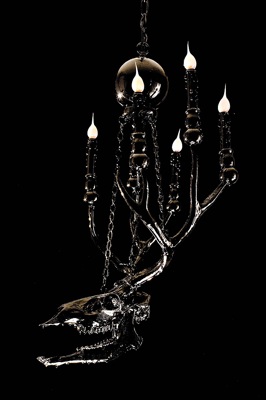  Several years ago, Cory posted about tentacle chandelier artist Adam Wallacavage. This master of wunderkammer fixtures has continued to hone his vision and craft leading to work like the piece above left, part of a new series he's hanging at Culver City, California's Corey Helford Gallery in a show opening this Saturday, March 19. Over at Ransom Notes, Stacey Ransom shows a stunning array of Wallacavage's lavish creations and Todd Selby's photos of the curious wonderland that Wallacavage calls home in Philadelphia (example, above right). Ransom Notes: Adam Wallacavage |
| Japan nuclear crisis: Where are the robots? Posted: 17 Mar 2011 10:23 AM PDT  Today, Reuters asked the questions we've all been thinking. Namely, "This is Japan, right? They've got lots of robots, right? So why aren't there robots helping out at Fukushima?" The answer they got is somewhat unsatisfying. Mostly, there's a lot of, "Nope, no robots being used right now. Sorry." But there are a couple of interesting facts in the article. • Robots are a part of the wider nuclear industry, capable of doing tasks like detecting radiation, and scaling walls. And robots were used in cleanup at Three Mile Island and Chernobyl. • There are no robots currently working at Fukushima Daiichi. It's unclear why. Although, there is, apparently, one radiation-detecting robot on site. • There is one possible reason why robots aren't being used at Fukushima. It all comes back to power plant design. A South Korean nuclear official told Reuters that robots and power plants have to be designed with each other in mind. Fukushima Daiichi, which dates to the 1970s, may simply not be navigable to newer nuclear helper 'bots. Reuters: Japan a robot power everywhere, except at nuclear plant Via Jer Thorp Image: Some rights reserved by ChelseaWa |
| Posted: 17 Mar 2011 10:20 AM PDT 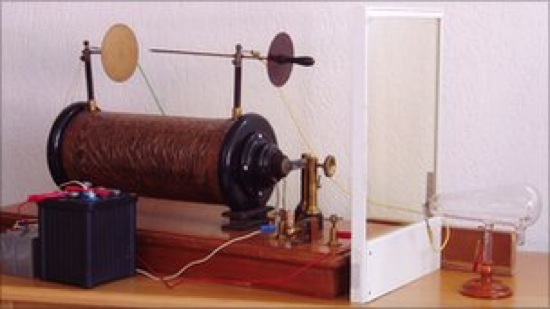 Researchers have fired up an 1895 x-ray machine to compare its images to that of a modern system. A physician from Maastricht University Medical Center in the Netherlands dusted off the antique machine, built by a local hospital director and high school director just weeks after X-ray discoverer Wilhelm Roentgen described his own system in a scientific journal. The pair, H J Hoffmans and Lambertus Theodorus van Kleef, homebrewed their machine from parts scavenged from the high school. The antique, operating under the same conditions outlined by Hoffmans and van Kleef, required a radiation dose 1,500 times higher than delivered by the current system to achieve comparable results. The antique's image is the one on the left. From the BBC News: "X-ray machine from 1896 compared to modern version" (Thanks, Bob Pescovitz!) |
| New York Times paywall: wishful thinking or just crazy? Posted: 17 Mar 2011 10:17 AM PDT  The New York Times just announced a new paywall that will let you see 20 articles a month and thereafter redirect you to a signup for paid access. However, if you follow a NYT link from some search engines and services like Twitter, you will be able to see the article even if you have exceeded your limit. This won't work. Here are some predictions about the #nytpaywall: 1. No one will be able to figure out how it works. Quick: How many links did you follow to the NYT last month? I'll bet you a testicle* that you can't remember. And even if you could remember, could you tell me what proportion of them originated as a social media or search-engine link? 2. Further to that, people frequently visit the NYT without meaning to, just by following a shortened link. Oftentimes, these links go to stories you've already read (after all, you've already found someone else's description of the story interesting enough to warrant a click, so odds are high that a second or even a third ambiguous description of the same piece might attract your click), but which may or may not be "billed" to your 20-freebies limit for the month 3. And this means that lots of people are going to greet the NYT paywall with eye-rolling and frustration: You stupid piece of technology, what do you mean I've seen 20 stories this month? This is exactly the wrong frame of mind to be in when confronted with a signup page (the correct frame of mind to be in on that page is, Huh, wow, I got tons of value from the Times this month. Of course I'm going to sign up!)
|
| Posted: 17 Mar 2011 10:44 AM PDT S.J. Culver writes: "I got a rejection note for a short story I had sent out to a magazine 838 days previously. ... while that magazine was considering whether to publish my 16-page story: I grew my hair ten inches; I paid off a car loan, I did my taxes (three times); I got my own apartment; I read 131 books; I attended two weddings and a baby shower; I cut my hair off again; I drove across the country three times." |
| Let's hope they have robotic fire trucks in Fukushima Posted: 17 Mar 2011 10:15 AM PDT  Todd Lappin says: "Do they have robotic fire trucks like these at Fukushima? Let's hope so." If they don't, they should launch a Kickstarter campaign to buy a few dozen. I'd contribute! |
| Posted: 17 Mar 2011 10:12 AM PDT |
| Nursery Rhymes: iOS app for parents who don't have time for their kids Posted: 17 Mar 2011 09:56 AM PDT There's no doubt that Nursery Rhymes is a beautiful iOS application, but the promotional video, which showcases its remote reading feature, is very sad. |
| How nuclear reactor design played a role in Fukushima crisis Posted: 17 Mar 2011 09:55 AM PDT Watch the full episode. See more PBS NewsHour. On Monday, PBS Newshour had a special report on the Fukushima nuclear crisis with Miles O'Brien and David Brenner, director of the Center for Radiological Research at Columbia University. The breaking "what's happening now" parts of this are somewhat outdated at this point—apologies for not getting it up sooner—but there's some really interesting tidbits in here about nuclear power plant design, what was weird about Fukushima Daiichi, and what is different between this power plant and nuclear power plants in the United States. From the transcript:
It's stuff like this that led Germany to shut down eight of its older nuclear reactors for the next three months, just to make sure there aren't similar safety flaws that have gone unnoticed there. If you want to understand a bit more about nuclear reactor design there's a couple of new news stories that talk about the design's role in the current Fukushima crisis: I would also highly recommend reading the MIT report on the future of nuclear energy. This paper is written to be readable by non-scientists, and it gets into the design differences—and the safety implications of those differences—between the generations of reactors. |
| The Decemberists by Scott Compton (Boing Boing Video) Posted: 17 Mar 2011 01:28 PM PDT [YouTube link, and here's a downloadable MP4] In case you're not hip to The Decemberists, they're a fantastic indie/folk/rock outfit from Portland, Oregon who took 15 years to become an overnight success. Their influences are diverse, from 1960s British folksters like Shirley Collins and Anne Briggs to 1980s modern rock songwriters like XTC, REM, and Morrissey. In January, the band released its sixth album, an epic alt.country/bluesy work titled The King Is Dead and took to the road. When their wagon train came through Oakland's Fox Theater in February, Boing Boing pal and hypertalented video director Scott Compton made the scene. BB readers may remember Scott for directing the Swell Season interview/performance film in 2009 that quickly became a Boing Boing Video fave. The Decemberists' timing was impeccable as it was Valentine's Day--and Scott, well, loves The Decemberists. Scott rallied his crack video team: the inimitable Bart Nagel and Chris Valente on Canon 5D cameras and Lauretta Molitor on sound -- for 20 minutes with the band and stageside access for a couple tunes. Then he took the footage back to his Remedy Editorial facility where editor Jeffrey Boyette and colorist Ayumi Ashley worked their post-production magic. The video team's passion and the band's talent gelled into the lovely piece you see above.
"In person, The Decemberists were humble, smart, and collaborative," Scott says. "For me, it was really interesting to hear singer/songwriter Colin Meloy talk about how Neil Young's seminal 'Comes A Time' album was a big influence. I discovered that album my freshman year of college, and missed a lot of classes sitting in my dorm listening to it again and again." Credits: Scott Compton (director), Chris Valente (producer), Bart Nagel (camera), Scott Compton (camera), Chris Valente (camera), Lauretta Molitor (sound), Camilla Comanich and Stephan Hawk (production assistance), Jeffrey Boyette (editor), Ayumi Ahsley (colorist), Mike Lowe (visual effects), Marc Pittman (sound mix) For more:
"The Decemberists and Polaroid" (Boing Boing)
|
| Young teen makes candles with "manly" scents Posted: 17 Mar 2011 09:28 AM PDT Hart Main, age 13, of Marysville, Ohio has launched a new company to sell "Mancans," candles scented with what he considers manly odors like pizza, sawdust, bacon, and baseball mitts. From the AP: "Ohio boy sells manly scented candles" (Thanks, Charles Pescovitz!) |
| World's largest spam botnet goes down (for now?) Posted: 17 Mar 2011 04:25 AM PDT Brian Krebs reports on the takedown of the command-and-control servers for Rustock, the largest and most successful spam botnet. The botnet's output has fallen from thousands of spams per second to one or two spams per second: Rustock Botnet Flatlined, Spam Volumes Plummet (Image: Spam wall, a Creative Commons Attribution Share-Alike (2.0) image from 63056612@N00's photostream)
|
| You are subscribed to email updates from Boing Boing To stop receiving these emails, you may unsubscribe now. | Email delivery powered by Google |
| Google Inc., 20 West Kinzie, Chicago IL USA 60610 | |

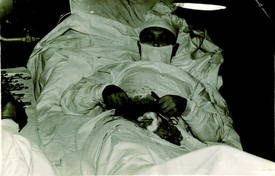 I worked without gloves. It was hard to see. The mirror helps, but it also hinders -- after all, it's showing things backwards. I work mainly by touch. The bleeding is quite heavy, but I take my time -- I try to work surely. Opening the peritoneum, I injured the blind gut and had to sew it up. Suddenly it flashed through my mind: there are more injuries here and I didn't notice them ... I grow weaker and weaker, my head starts to spin. Every 4-5 minutes I rest for 20-25 seconds. Finally, here it is, the cursed appendage! With horror I notice the dark stain at its base. That means just a day longer and it would have burst and ...
I worked without gloves. It was hard to see. The mirror helps, but it also hinders -- after all, it's showing things backwards. I work mainly by touch. The bleeding is quite heavy, but I take my time -- I try to work surely. Opening the peritoneum, I injured the blind gut and had to sew it up. Suddenly it flashed through my mind: there are more injuries here and I didn't notice them ... I grow weaker and weaker, my head starts to spin. Every 4-5 minutes I rest for 20-25 seconds. Finally, here it is, the cursed appendage! With horror I notice the dark stain at its base. That means just a day longer and it would have burst and ...  7.05pm ET: There's some very impressive singing in central Benghazi, accompanied by celebratory gunfire, right now, based on al-Jazeera's footage.
7.05pm ET: There's some very impressive singing in central Benghazi, accompanied by celebratory gunfire, right now, based on al-Jazeera's footage.  The Coava Disk is a perforated steel plate designed to replace the paper filters in your
The Coava Disk is a perforated steel plate designed to replace the paper filters in your 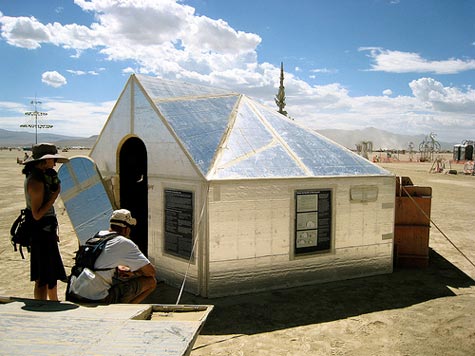
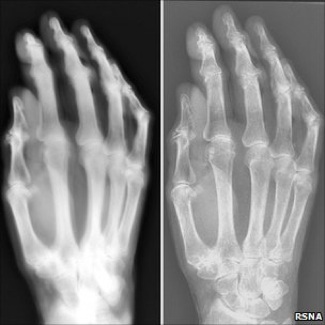 The team carefully recreated the experimental conditions that the machine's inventors would have used.
The team carefully recreated the experimental conditions that the machine's inventors would have used.  ...He got the idea for his "Mancans" when he was making fun of his sister for selling candles with girly scents for a school fundraiser. Columbus station WCMH-TV reports he launched his company last Thanksgiving, making the candles using scores of empty cans from soup he donated to a soup kitchen.
...He got the idea for his "Mancans" when he was making fun of his sister for selling candles with girly scents for a school fundraiser. Columbus station WCMH-TV reports he launched his company last Thanksgiving, making the candles using scores of empty cans from soup he donated to a soup kitchen. It may yet be too soon to celebrate the takedown of the world's largest spam botnet. For one thing, PCs that were infected with Rustock prior to this action remain infected, only they are now somewhat lost, like sheep without a shepherd. In previous takedowns, such as those executed against the Srizbi botnet, the botmasters have been able to regain control over their herds of infected PCs using a complex algorithm built into the malware that generates a random but unique Web site domain name that the bots would be instructed to check for new instructions and software updates from its authors. Using such a system, the botmaster needs only to register one of these Web site names in order to resume sending updates to and controlling the herd of infected computers.
It may yet be too soon to celebrate the takedown of the world's largest spam botnet. For one thing, PCs that were infected with Rustock prior to this action remain infected, only they are now somewhat lost, like sheep without a shepherd. In previous takedowns, such as those executed against the Srizbi botnet, the botmasters have been able to regain control over their herds of infected PCs using a complex algorithm built into the malware that generates a random but unique Web site domain name that the bots would be instructed to check for new instructions and software updates from its authors. Using such a system, the botmaster needs only to register one of these Web site names in order to resume sending updates to and controlling the herd of infected computers.
No comments:
Post a Comment